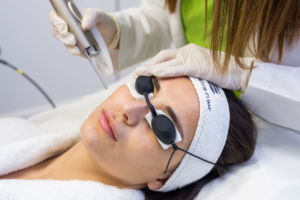Understanding Pigment Laser Treatment: A Comprehensive Guide
4 min read
Before and after cosmetic operation. Young pretty woman portrait, isolated on a white background. Before and after cosmetic or plastic procedure, anti-age therapy
Pigment laser treatments have become a popular solution for those seeking to address skin pigmentation issues such as dark spots, melasma, freckles, and uneven skin tone. With advancements in dermatological technology, pigment lasers offer a non-invasive, efficient, and targeted approach to achieving clearer and more radiant skin. This article explores what pigment laser treatments are, how they work, their benefits, and considerations before undergoing the procedure.
What is Pigment Laser Treatment?
Pigment laser treatment is a dermatological procedure that uses focused light energy to target and break down excess melanin in the skin. Melanin is the pigment responsible for skin color, and its overproduction can lead to hyperpigmentation or dark patches. Pigment lasers are designed to treat these discolorations while leaving the surrounding skin unaffected.
There are several types of pigment lasers, each with specific applications:
- Q-Switched Nd:YAG Laser: Commonly used for deeper pigmentation issues like melasma and post-inflammatory hyperpigmentation.
- PicoSure Laser: Utilizes ultra-short pulses to break down pigment particles and stimulate collagen production.
- Fraxel Laser: A fractional laser that targets pigmentation while also improving overall skin texture.
- Ruby Laser: Effective for lighter pigmentation such as freckles and sunspots.
How Does Pigment Laser Work?
Pigment lasers emit specific wavelengths of light that are absorbed by the melanin in the skin. When the melanin absorbs the laser energy, it heats up and breaks into smaller particles. These particles are then naturally eliminated by the body’s immune system.
The procedure is precise, ensuring that only the pigmented areas are treated. Depending on the severity of the pigmentation and the type of laser used, multiple sessions may be required for optimal results.
Benefits of Pigment Laser Treatment
- Effective Results
Pigment laser treatments are highly effective in reducing or eliminating various pigmentation issues, providing a more even and radiant complexion. - Non-Invasive
Unlike surgical procedures, pigment laser treatments are non-invasive, requiring no incisions or downtime. Most patients can return to their daily activities shortly after the session. - Customizable
Dermatologists can tailor the treatment to the specific needs of the patient, ensuring optimal results for different skin types and pigmentation concerns. - Stimulates Skin Renewal
Many pigment lasers also promote collagen production, which improves skin elasticity, texture, and overall appearance. - Long-Lasting Effects
With proper care and maintenance, the results of pigment laser treatments can be long-lasting.
Preparing for Pigment Laser Treatment
Before undergoing pigment laser treatment, it’s essential to consult a qualified dermatologist. They will assess your skin type, the nature of the pigmentation, and your medical history to determine the best course of action.
Here are some preparation tips:
- Avoid Sun Exposure: Protect your skin from the sun to minimize the risk of post-treatment complications.
- Stop Certain Skincare Products: Discontinue the use of products containing retinoids, AHAs, or BHAs a few days before the procedure.
- Stay Hydrated: Hydrated skin responds better to laser treatments and heals more quickly.
The Procedure: What to Expect
A typical pigment laser session involves the following steps:
- Cleansing: The skin is thoroughly cleaned to remove any makeup, oils, or impurities.
- Application of Cooling Gel: A cooling gel may be applied to minimize discomfort during the procedure.
- Laser Application: The dermatologist uses the laser device to target pigmented areas. The duration of the session depends on the size of the treatment area.
- Post-Treatment Care: After the session, a soothing cream is applied, and sunscreen is recommended to protect the skin.
Most patients describe the sensation during treatment as a mild prickling or tingling. Any redness or swelling typically subsides within a few hours.
Post-Treatment Care
Proper aftercare is crucial for achieving the best results and avoiding side effects. Here are some tips:
- Use Sunscreen: Protect your skin from UV rays by applying a broad-spectrum sunscreen with at least SPF 30.
- Avoid Harsh Products: Refrain from using exfoliants or strong skincare products for a few days post-treatment.
- Keep the Skin Moisturized: Use gentle, hydrating products to maintain the skin’s moisture barrier.
- Follow Up: Attend follow-up sessions as recommended by your dermatologist for optimal results.
Considerations and Risks
While pigment laser treatments are generally safe, they may not be suitable for everyone. Individuals with darker skin tones or certain medical conditions should consult their dermatologist to evaluate the risks. Potential side effects include:
- Temporary redness or swelling
- Mild peeling or flaking
- Rare cases of post-inflammatory hyperpigmentation
Selecting a qualified and experienced professional reduces the likelihood of complications.
Conclusion
Pigment laser treatment is a revolutionary solution for addressing pigmentation issues and enhancing skin clarity. Its non-invasive nature, customizable approach, and ability to deliver significant results make it a sought-after option for those striving for flawless skin.
However, the success of the treatment depends on factors such as the type of laser used, the skill of the practitioner, and adherence to pre- and post-treatment guidelines. If you’re considering pigment laser treatment, consult a trusted dermatologist to ensure it’s the right choice for your skin’s needs.





